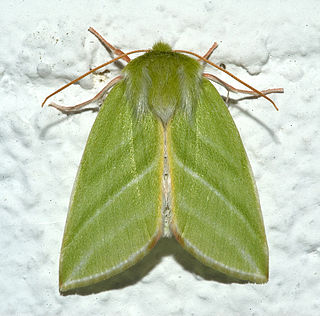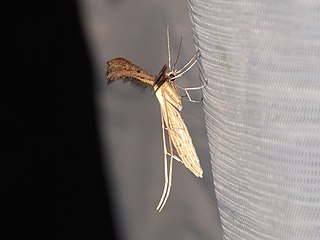
The Arctiinae are a large and diverse subfamily of moths with around 11,000 species found all over the world, including 6,000 neotropical species. This subfamily includes the groups commonly known as tiger moths which usually have bright colours, footmen which are usually much drabber, lichen moths, and wasp moths. Many species have "hairy" caterpillars that are popularly known as woolly bears or woolly worms. The scientific name Arctiinae refers to this hairiness. Some species within the Arctiinae have the word tussock in their common name because they have been misidentified as members of the Lymantriinae subfamily based on the characteristics of the larvae.

The Pterophoridae or plume moths are a family of Lepidoptera with unusually modified wings. Though they belong to the Apoditrysia like the larger moths and the butterflies, unlike these they are tiny and were formerly included among the assemblage called "microlepidoptera".

Nolidae is a family of moths with about 1,700 described species worldwide. They are mostly small with dull coloration, the main distinguishing feature being a silk cocoon with a vertical exit slit. The group is sometimes known as tuft moths, after the tufts of raised scales on the forewings of two subfamilies, Nolinae and Collomeninae. The larvae also tend to have muted colors and tufts of short hairs.

The Cochylini are a tribe of tortrix moths. It used to be classified as the subfamily Cochylinae.

Stenoptilia zophodactylus, also known as the dowdy plume, is a species of moth of the family Pterophoridae found worldwide. It was first described by Philogène Auguste Joseph Duponchel in 1840.

Gillmeria pallidactyla is a moth of the family Pterophoridae first described by the English entomologist, Adrian Hardy Haworth in 1811. It has a Holarctic distribution and is widespread throughout North America and the Palearctic.
Tomotilus celebratus is a moth of the family Pterophoridae. It has been reported from Australia, India, Japan and Indonesia (Java). Until recently the species was known as Tomotilus saitoi, but the earlier name Oxyptilus celebratus has been recognised as an earlier reference to this same species.

Anstenoptilia marmarodactyla is a moth of the family Pterophoridae. It is native to California and Arizona, south through Mexico to Costa Rica. It is an introduced species in Hawaii.

Megalorhipida is a genus of moths in the family Pterophoridae described by Hans Georg Amsel in 1935. Species in this genus are distributed in pantropical and subtropical climates. The species typically nests on host plants in the families Nyctaginaceae, Amaranthaceae, Fabaceae, Goodeniaceae, Asteraceae, and Verbenaceae. The generic name is often misspelled as Megalorrhipida. The species formerly placed in the genus Antarches are now considered to belong to this genus.
Exelastis montischristi is a species of moth in the genus Exelastis known from Hispaniola, Ecuador, Grenada, Jamaica, Martinique, the Virgin Islands, Florida and Texas. It has also been recorded from Tanzania.
Stenoptilodes brevipennis is a moth of the family Pterophoridae. It is known from Argentina, Belize, Brazil, Costa Rica, Cuba, Ecuador, Mexico, Paraguay, Peru, Puerto Rico, Suriname, Trinidad and Uruguay, as well as most of the United States and southern Canada.
Michaelophorus nubilus, the cacao plume moth, is a species of moth in the genus Michaelophorus known from Venezuela, Peru, Ecuador, Brazil, Colombia, Honduras, Costa Rica, and Trinidad. Moths of this species take flight in January, February, and July and have a wingspan of approximately 12–15 millimetres (0.47–0.59 in).
Stenoptilia pallistriga is a moth of the family Pterophoridae described by William Barnes and James Halliday McDunnough in 1913. It is known from Dominica, Ecuador, Jamaica, Paraguay and Suriname. It is also found in the United States in Florida and Mississippi.
Paraplatyptilia fragilis is a moth of the family Pterophoridae. It was described by Lord Walsingham from the Klamath Lakes area in northern California, and has a wide range in the Great Basin, inland montane and desert ranges from eastern British Columbia to Utah, and from New Mexico to southern California and Baja California Norte in Mexico.
Postplatyptilia pusillus is a moth of the family Pterophoridae. It was described by Rodolfo Amando Philippi in 1864.
Stockophorus charitopa is a moth of the family Pterophoridae and the only member of the genus Stockophorus. It is known from Bolivia.
The Micronoctuini are a tribe of moths in the family Erebidae that includes about 400 described species. Typical species in the tribe have bifine hindwing venation and are smaller than those in other noctuoid moths. Micronoctua karsholti is the smallest of all species in the superfamily Noctuoidea.

Pterophorinae is a subfamily of moths in the family Pterophoridae.

Crombrugghia tristis is a moth of the family Pterophoridae. It is found in most of Europe, except the Benelux, Great Britain, Ireland and Scandinavia. It is also known from southern Siberia, Asia Minor and central Asia. The habitat consists of sandy areas overgrown with Hieracium.
Melanoptilia is a genus of moths in the family Pterophoridae described by Cees Gielis in 2006. All described species come from Latin America.










